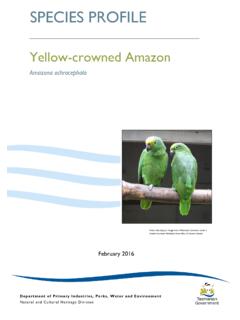Transcription of PSITTACOSIS PREVENTION CHECKLIST - NASPHV
1 PSITTACOSIS and Avian Chlamydiosis CHECKLIST for Owners of Infected Birds PSITTACOSIS ( parrot fever) is a bacterial infection of humans resulting from exposure to infected birds, usually psittacine birds ( , parakeets, cockatiels, conures, parrots, and macaws). The infection in birds is called avian chlamydiosis. Healthy appearing birds can be infected and shed the bacteria when stressed, causing infection of other species of birds ( , finches, canaries, and doves) housed in the same environment. Following these guidelines will aid in the PREVENTION of avian chlamydiosis and reduce the risk of transmission from birds to caretakers. EDUCATE all persons in contact with infected or exposed birds. Explain that this disease can spread from birds to people and that they can help prevent human infection and minimize the disease spread among birds if they follow the information provided below.
2 Bird caretakers with flu-l ike symptoms should seek prompt medical care and inform their healthcare provider about their bird contact. PROTECT CARETAKERS by wearing protective clothing when handling birds confirmed with avian chlamydiosis and any birds exposed ( , within the same enclosure or air space) to confirmed avian cases or cleaning their cages. Wear gloves, coveralls or disposable gowns, disposable caps, protective eyewear ( , goggles) and a properlyfitted respirator mask ( a pre-s haped mask that molds firmly around the mouth and nose).PRACTICE GOOD HUSBANDRY to reduce stress in birds. Maintain good nutrition. Keep all food and treats in a separate room in closed containers.
3 Isolate newly acquired birds, from all other birds, for 30 days and observe for illness. Separate birds ( , group in separate rooms, utilize barriers between cages, etc.) to preventbird to bird contact and cross contamination of feathers, food and other cage materials. Minimize stress ( relocation, unnecessary handling, chilling, overheating).CLEAN & DISINFECT Effective disinfectants include bleach and water (1:32 dilution or cup bleach per gallon of water), 1% Lysol ,quaternary ammonia compounds or accelerated hydrogen peroxide products. Most disinfectants require 5-10 minutes of contact time on a surface free of any fecal material and/or cage debris tobe effective. Frequently remove waste material from cages and prevent aerosolization by moistening waste material in cageswith a disinfectant solution prior to removal and double bag all waste.
4 Clean and care for healthy birds before ill birds. Clean and disinfect all cages, food and water bowls daily and whenever moving birds. Wash with detergent, rinsewith water, then apply disinfectant (allow appropriate contact time), and rinse with water. Wet mop the floor frequently with disinfectant solution to minimize aerosolization of dried feces, dust, and feathers. Spray floor with disinfectant before sweeping. Do not use a vacuum cleaner or pressure ACCURATE RECORDS of all birds for at least one year. Records should include bird identification, species, source, date acquired, date of illness, clinical signs of disease,treatment, and bird deaths. If birds are sold or transferred to another owner, the name, address, and phone numberof the new owner, and bird identification information and date of transaction should be newly acquired birds or those that may have been exposed to infected bird(s).
5 Bird testing and treatment should be conducted or supervised by an experienced avian ill birds from all other birds Clinical signs of avian chlamydiosis include lethargy, loss of appetite, ruffled feathers, and might include eye andnasal discharge, bright green diarrhea, and/or low body weight. Never sell or distribute ill TREATMENT PROTOCOLS Follow all instructions from the treating veterinarian for treatment, isolation and quarantine, follow-up testing andhandling of the ill and exposed birds. Continue medication for the full treatment period as established by the veterinarian. Remove sources of calcium ( , mineral block, oyster shell, and cuttlebone) from cages as these supplementsmay inhibit absorption of the treatment medication, reducing the likelihood that treatment will be from Compendium of Measures to Control Chlamydia psittaci Infection Among Humans ( PSITTACOSIS ) and Pet Birds (Avian Chlamydiosis), National Association of State Public Health Veterinarians ( NASPHV ) 2017.
6








